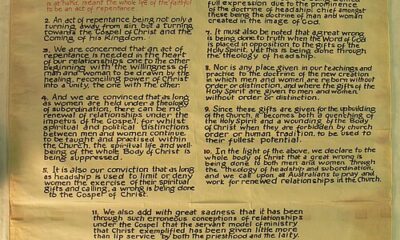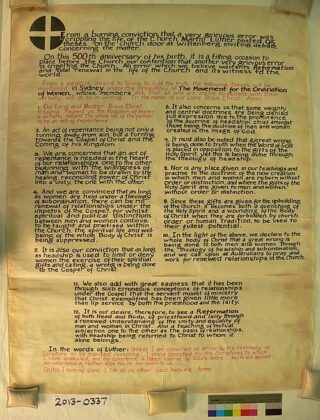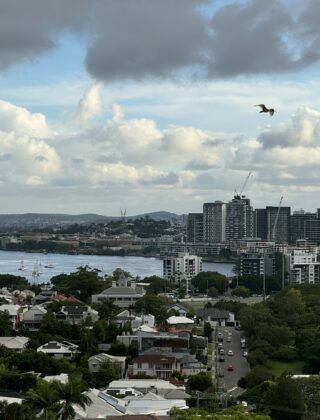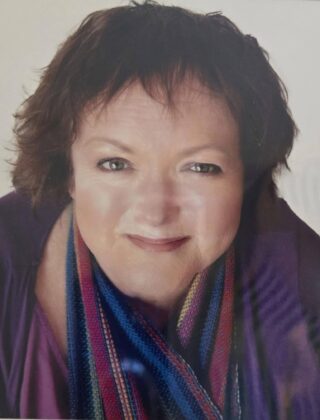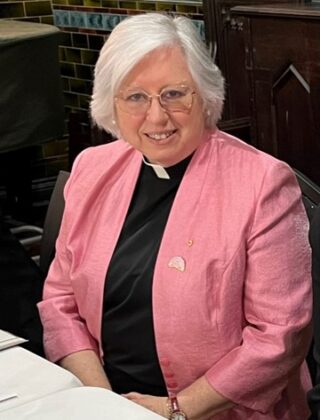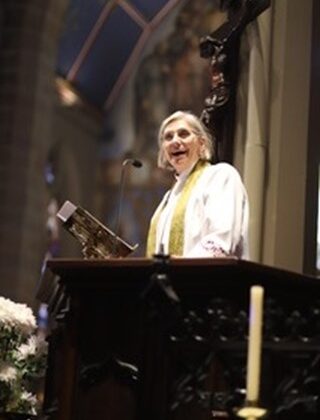Mystics, Theologians & God-Botherers: Patricia Brennan
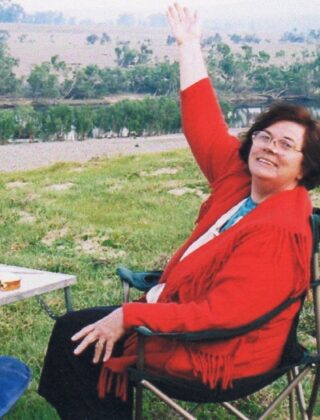
Dr Patricia Brennan – A prophet of our times
Address by Dr Gwenneth Roberts, at St John’s Cathedral in Brisbane on 7 March 2021
May we plumb the depths of God as I speak these words, in Jesus the Christ. Amen.
Your mind burns
Not like the harbour beacon
But like a fire
Of fiercer origins
You begin speaking out
And a great gust of freedom
Rushes in with your words
Yet still you speak
In the shattered language
Of a partial vision
– A poem by Adrienne Rich
Patricia Brennan, a prophet of our times, medical doctor, forensic physician, missionary, wife, mother, grandmother, television presenter, poet, and sculptor.
Patricia’s son Peter says, “Mum acted like someone who knew that they were expected to play a part in the destiny of the human race, and of course she did. She went straight to the heart of matters; she saw the deeper meaning behind the surface. She also gave voice to that which was clearly evident but habitually ignored. Elephants in rooms tended to honk nervously when Mum walked through the door”.
In this presentation I invite you to consider some of the characteristics we see in the prophets of Scripture as we look at the life of Patricia Brennan – justice, anger, truth, righteousness.
She was born in 1944 into a working class family and grew up in a friendly middle Anglican Church. She thought there were probably no radical thinkers in her church, but she said “kneeling in the Choir I used to be having quite a few radical thoughts of my own when I was about 12”.
At High School she delighted in ideas, was skilled in debating, and loved poetry. A scholarship to Sydney University enabled her to study medicine.
After graduation and internships she became a missionary in Africa, in Niger, at the edge of the Sahara. There were no doctors for hundreds of kilometres. She says, “I saw the tremendous suffering of women, they were about the same level as the beasts. Missionaries didn’t address these issues politically, it was not culturally appropriate. It had to be addressed by preaching the gospel of salvation, and I think that was the beginning of my SEEING”. Africa opened up Patricia’s eyes in more ways than she could have imagined. She said, “Violence was only just emerging in my mind then as associated with gender and associated with religion”.
The treatment of women missionaries when they returned home rankled with Patricia. It was an amazing transition. They couldn’t get up in the pulpit and preach, although men could. She saw this as a status difference.
In 1982 Patricia was appointed to a Sydney Diocesan Committee to consider women’s ministry. She conducted a survey of theological students and women training for ministry, including questions about women’s ordination. This research project revealed deep dissatisfaction with the Anglican Church. When she submitted her findings to the Sydney committee they were disregarded.
These experiences propelled her to become the founder and President of the National Movement for the Ordination of Women (MOW) in the Australian Anglican Church in 1984. It was in this role that she took on the mantle of a prophet. She said “The prophetic tradition has been one of bringing greater clarity to the purposes of God and it has both a negative and positive aspect: negative, because it rejects the dominant culture and exposes it as wrong; positive because it is radical, meaning it goes back to the root of the very intentions of God in revealing God’s purposes”.
She became a public figure and a spokesperson for that movement. But as she said, “Don’t confuse the role of a prophet with that of a spokesperson for a group. A passion for speaking against injustice comes from the viscera as much as the mind and therefor the prophetic voice is not necessarily the most reasonable or the most measured of voices”. She contrasted the role of a spokesperson and prophet as asking a committee to write a poem. Patricia has been recognised as the most influential single individual who put the ordination of women on the agenda and kept it in full public view.
When she was part of the formation of MOW in Sydney she insisted that the word “ordination” be included in the name of the organisation. Some wanted to call it ‘Women in Ministry’. Well, she said, that’s like you want to be a doctor and you talk about women in health. If you call it women’s ordination you will name the problem. Women who were there intellectually and emotionally were not there politically or theologically. So we had to convince our own side to even go public on the name. The risk was, as the prophet Isaiah said of the people “…speak to us of smooth things…”.
We were frightened to confront the patriarchal Church of almost 2000 years. But the words of Zechariah rang out “Do not be afraid…speak the truth to one another”.
In her Presidential messages Patricia encouraged members of MOW, she said “…too often we draw our perceptions of ourselves from those who oppose us, and not those who bless us or who give us our model. So, therefore when we are described as aggressive, we own aggression; when we are described as damaged we own damage, or even worse, we draw our view of ourselves like Narcissus, from gazing at ourselves morbidly, but it’s when we look to each other in relationship, in community – something about the Eucharist is there. Then we gain affirmation, not from our greatness, but from Christ’s possibilities being imaged in each other”.
The weight of oppression on women in the church is powerful indeed, and to continue to ask us to be silent and wait patiently is akin to asking a woman during a difficult labour not to make a noise.
Patricia had a great way with words and debate, particularly her ‘one liners’ which the media loved. As her successor as President of National MOW, Dr Janet Scarfe, said, “her words were not empty spin, they were informed, insightful and devastatingly incisive”. She turned the word ‘strident’ which was often used of women in a derogatory sense into ‘stir and tend’. She did disturb the ‘comfortably churched’ and tended to those who were distressed by their sometimes cruel treatment by the church. Patricia could speak to people on the edges who many of us sometimes found too difficult. Patricia had compassionate imagination. Another one of the sayings she used in MOW was ‘loving defiance’.
Her late husband Rob said “There were church leaders (…) who often brought forward the excuse that they would not talk to her so long as she remained angry… Well, Patricia was not going to be calm and dispassionate because it was an issue that came from her gut”.
Patricia responded “Anger is a thing that Anglicans do not like, especially in a woman. But it’s not about me and so it was about the public. So when anyone responded to a better way of treating someone (…) that kept me going, even though I was full of self-doubt at times and being attacked by both sides and feeling not as tough as I looked”.
Patricia said “My secret was not that I was a calculating politician, always less the conscious strategist, more the closet poet. It was poetry that fuelled my energy…that gave me a passion to speak for those without a voice. I wasn’t even able to be put off by alternate lobby groups within. As one supporter of women priests put it “get off TV Patricia Brennan. Every time you speak we lose a vote”. I was smitten by that retort…but regathered my skirts and thought later – “Yeah, the point is who reverses a conscience vote because of one person when a generation stands to be affected by injustice? So forget that voter”.
Patricia had a great sense of humour and the dramatic. MOW concerts were a place where satire of the Church and its history was often performed in song and drama, a healing balm for the opposition and oppression we experienced. Who could forget her impersonations of Elizabeth Schussler-Fiorenza, feminist theologian, with her thick German accent, or of being interviewed as Saint Augustine on his attitudes towards women?
Women were ordained in the Anglican Church of Australia in 1992. Patricia was then back in Sydney where she had started 20 years ago. She said “This meant the end of my prophetic role…with what was locally not only a failed quest but patently hailed as a victory for true Christianity. I could no longer pew sit under the authority of the Jensens and Moore College. I went into existential mourning in the desert. Like Peter after the crucifixion, I took my concerns back to fishing. That is medicine, except that I chose to relive reform by becoming a forensic physician working in Emergency Departments and courts with abused patients especially women and children but without gender bias, sometimes with fierce opposition”. She made her impact in this area. In 2009 she became acting Medical Director of the clinical Forensic Unit of NSW Police, and in 2010 she was appointed a Visiting Fellow in Law at the University of NSW. Sadly, Patricia died in 2011. She is remembered at the Liverpool Sexual Assault Unit in Sydney where she was Medical Director. It is named The Brennan Unit in her honour.
We give thanks for the life of Patricia Brennan and for all poets, prophets, and writers.
AMEN


